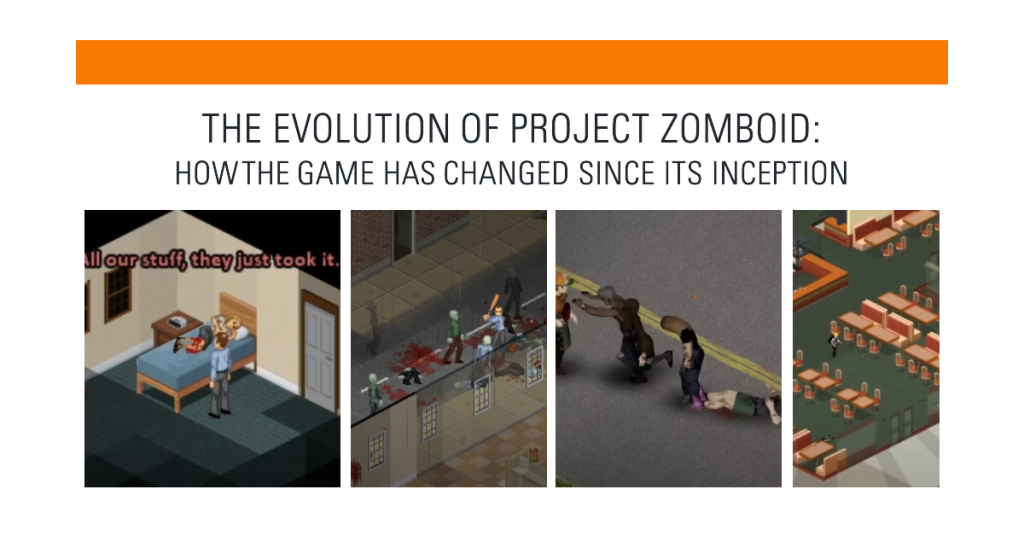The Evolution of Project Zomboid
In the vast world of video games, few experiences capture the essence of survival quite like Project Zomboid. From the moment it shuffled onto the scene, this indie gem has been captivating players with its gritty depiction of a zombie-infested world. But what does it take for a game to transform from its early days to its current state, evolving with new features, enhancements, and a passionate community? In this article, we're diving headfirst into the history of Project Zomboid to uncover its remarkable journey from its humble beginnings to the captivating experience it is today.
Early Days: From Concept to Alpha
The story of Project Zomboid begins with a spark of creativity and a lot of ambition. Born out of a desire to create a realistic and intense survival experience, the game's initial concept quickly garnered the attention of gamers who craved a more challenging zombie apocalypse. The developers' Kickstarter campaign was met with enthusiasm, setting the stage for the game's alpha release. Early players were introduced to a world teeming with potential, where the foundation of survival was laid down.
Alpha Release and Early Gameplay
As the first alpha build of Project Zomboid saw the light of day, players were greeted with a rough yet promising gameplay experience. The game introduced the basic mechanics that would set the tone for its future development. Crafting makeshift weapons, scavenging for supplies, and building rudimentary shelters were just a few of the challenges that players faced. The simplicity of the gameplay was both a strength and a point of growth for the game.

Community Feedback and Iterations
One of the defining aspects of Project Zomboid's evolution is the intimate relationship between the developers and the player community. Early adopters of the game provided valuable feedback that directly influenced the direction of development. Whether it was suggestions for new features, ideas for mechanics, or bug reports, the community's voice was not only heard but also actively embraced by the development team. This collaboration paved the way for a series of iterations that would shape the game's future.
Building the Foundation: Expanding Mechanics
The survival genre thrives on its mechanics, and Project Zomboid was no exception. Over time, the game evolved by introducing a multitude of new gameplay elements that transformed the experience into a nuanced and complex simulation of survival. Crafting and building systems were introduced, enabling players to construct more robust shelters and create essential tools for their survival. The game's mechanics expanded to include dynamic elements like hunger, thirst, and character health, adding layers of strategy to the gameplay.
Growing Survival Complexity
In the relentless world of Project Zomboid, survival is not just a matter of fending off the undead but also of managing your own well-being. As the game evolved, players had to contend with a more intricate survival ecosystem. Gathering food, purifying water, and treating injuries became essential tasks for long-term survival. The game's complexity ensured that players had to think critically about their actions, making every decision matter in the grand scheme of things.
Dynamic World and NPC Interaction
The transformation of Project Zomboid wasn't limited to internal mechanics; the game's world itself underwent significant changes. The introduction of day-night cycles and changing weather patterns brought a dynamic and immersive quality to the gameplay. Players had to adapt their strategies to the shifting conditions, enhancing the realism of the experience. Additionally, the inclusion of non-playable characters (NPCs) introduced a new layer of complexity to interactions within the game. Human encounters became both a potential boon and a risk, forcing players to weigh the benefits against the dangers.
Visual Overhaul: From Pixel Art to Enhanced Graphics
One of the most noticeable aspects of Project Zomboid's evolution was its visual transformation. The game transitioned from its original pixel art style to a more detailed and visually rich design. The overhaul resulted in environments that were more immersive and atmospheric. Lighting effects, environmental details, and enhanced character models all contributed to a heightened sense of immersion, bringing players even closer to the grim reality of the game's world.
Enhanced Environment Design
The enhanced graphics didn't just stop at character models; the entire game world received a facelift. Environments became more detailed and meticulously crafted, from abandoned buildings to overgrown streets. Each location had its own story to tell, and players were now able to explore these settings in greater detail. The visual overhaul also extended to the lighting and ambiance, with day and night cycles becoming more visually striking and evocative.
Advanced Gameplay: New Challenges and Content
As Project Zomboid continued to evolve, the game's development team didn't rest on their laurels. Instead, they introduced new challenges and content that enriched the player experience. The game's skill and trait system allowed players to specialize their characters, creating unique gameplay dynamics. The introduction of a medical system added another layer of complexity, requiring players to treat injuries and manage illnesses. New content, such as additional locations, items, and dynamic events, kept players engaged and invested in the evolving world.
Community and Modding Support: Player-Driven Innovation
One of the most remarkable aspects of Project Zomboid's evolution is the role of the player community in shaping its development. The game's modding community flourished, with players creating a diverse array of custom content that expanded the game's possibilities. The developers recognized this creative energy and officially embraced modding support, providing tools and resources for players to create and share their own content. The result was a game that not only evolved through official updates but also through the vibrant contributions of the player community.
Conclusion: Project Zomboid - A Game Still Evolving
As we reflect on the evolution of Project Zomboid, it's clear that the journey from its inception to its current state has been one of growth, adaptation, and community collaboration. The game's developers and players alike have worked together to shape the game into the captivating experience it is today. From its early alpha days to its current immersive gameplay, Project Zomboid is a testament to the power of iteration, innovation, and the enduring passion of the gaming community.
Embark on your own survival journey in Project Zomboid with GTXGaming's high-quality server hosting solutions. Our dedicated Project Zomboid servers offer a seamless and immersive gameplay experience, allowing you to explore the game's evolving world with friends or fellow survivors. Dive into the gripping gameplay and vibrant community of Project Zomboid on servers optimized for performance and reliability. Discover the possibilities of Project Zomboid server hosting and forge your own path in a post-apocalyptic landscape.



